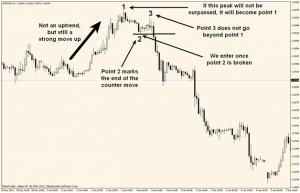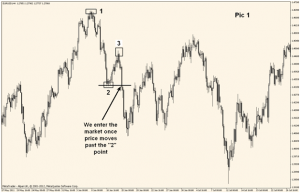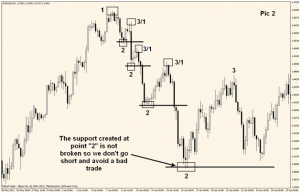Full Review of 1-2-3 Strategy – Easy as A-B-C
The “1 – 2 – 3” Strategy: Easy as A – B – C, profitable as an ATM?
Here I am again folks, looking to wipe the dust away from an old, classic price action strategy and bring it to you with the good, the bad and the ways we can adapt it for Binary Options trading. The strategy is simply named “1 – 2 – 3”. Let me tell you, in the days this strategy was born, marketing and trading did not go hand in hand and not everybody tried to sell you a strategy telling you that it uses a magic formula that also helped man to reach the Moon, invent hot water or other nonsense like that, hence the minimalistic name. The 1 – 2 – 3 strategy actually consists of a simple three point chart pattern; just look at Picture 1 below (without looking at Picture 2) and you will understand it perfectly (… you looked at Picture 2 also, didn’t you?). For a 1 – 2 – 3 Down we need point “1” to be the highest swing in the pattern and for a 1 – 2 – 3 Up we need point “1” to be the lowest swing in the pattern. This strategy is mainly a reversal one and the 1 – 2 – 3 Down will appear after an uptrend or at least after a move up. Conversely, the Up pattern will appear after a downtrend or at least a move down. The market is entered once the support or resistance formed by point “2” is broken. However, we don’t have a valid 1 – 2 – 3 Up pattern if point “3” is lower than point “1” and we don’t have a valid 1 – 2 – 3 Down pattern if point “3” is higher than point “1”. In any case, if point “1” is surpassed by point “3” in the opposite direction, all bets are off and we can’t apply this strategy.
Why the “1 – 2 – 3” strategy sucks
I mentioned the words “reversal pattern” and that is where the strategy can start to suck. Everybody says “Go with the trend because it’s your friend” …and they are right, the probability of success is greater with trend entries. When trying to identify reversals, we can get burned easily if we were wrong and it turns out to be just a retracement. But we can avoid this by following the simple rule “…if point”1” is surpassed in the opposite direction, all bets are off”; this way, we don’t enter the market and keep our money safely in our pockets or, we can trade differently, according to the new conditions. Something that can keep a newbie away from this strategy is the fact that they can get easily confused by the 1 – 2 – 3 highs and lows, at least in the early period of using the strategy, but trust me, after a while, all the pieces of the puzzle will fall into place and things will be a lot clearer.
Why the “1 – 2 – 3” strategy doesn’t suck
This strategy withstood the test of time and it’s been used by Forex traders, stock traders and equities traders, being a pure price action strategy, with sound support and resistance principles. It is mainly referred to as a reversal strategy, but it can also be used in line with the trend. Ok, now look at Picture 2 and notice how the highs and lows are numbered in the newly formed downtrend and how many Put opportunities we had, all successful. In Picture 2 we enter the market each time the support formed at point “2” is broken. Most important, all the trades were taken with the trend. Also, we are protected by a bad trade: in Picture 2, our trigger to enter the market again would be the break of the last point “2” (the lowest one), but since this doesn’t happen, we stay away of a losing trade.
How to use the “1-2-3” Strategy
First, you need to use proper charting software and set up an almost naked chart because we are interested in price swings, not some lagging indicator. I am going to explain a 1 – 2 – 3 Down pattern, but keep in mind that all the rules also apply for an Up pattern, reversed of course. After an uptrend or at least a strong move up, we must look for the 1 – 2 – 3 pattern to form, starting of course with the first peak (1). This peak will also become the top of the trend if our strategy works out (if price continues it’s up move, we will mark the new high as point 1). Now a counter move will begin and we will mark the bottom of that move with 2. At the moment we have an uptrend and a retracement that just ended and price started to move up. If this new move up will surpass our initial point 1, all bets are off, like I said and we go drink our beverage of choice while we wait for another setup. If the new move up does not surpass point 1 and starts turning down, we will mark the highest point of this new move up with 3. Now our pattern is complete, but there is still a very important rule that we have to follow: price must move down to break the low created at point 2. If that happens, all our conditions are met, we enter the trade by selecting Put and again, we go drink our favorite beverage. The outcome of the trade is out of our hands now, but at least we know the strategy was followed as it should. If all the explanation confused you, here’s a picture to help:



Conclusion – 1-2-3 Yay!
All I can say is that the 1 – 2 – 3 strategy has a big probability of becoming our personal ATM if used correctly, as per rules described in the first paragraph and it also keeps us out of some bad trades. But sometimes the market moves so hectic that all our strategies are messed up and for some reason, they all fail. Not being the “Holy Grail”, this strategy is also prone to false signals, whipsaws and other ugly stuff that the market throws at us. Overall, it’s a good strategy in my opinion and I personally traded it many times with success, but it also gave me some headaches.
Click here for more information or ask our experts for more details on the forum.